
Dallas County is a county located in the central part of the U.S. state of Alabama. As of the 2010 census, its population was 43,820. The county seat is Selma. Its name is in honor of United States Secretary of the Treasury Alexander J. Dallas, who served from 1814 to 1816.

Lowndesboro is a town in Lowndes County, Alabama, United States. At the 2010 census the population was 115, down from 140 in 2000. It is part of the Montgomery Metropolitan Statistical Area. Although initially incorporated in 1856 by an act of the state legislature, it lapsed and was not reincorporated until 1962.
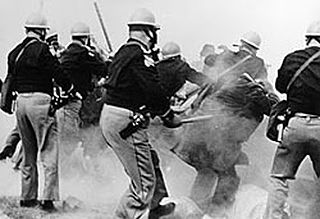
The Selma to Montgomery marches were three protest marches, held in 1965, along the 54-mile (87 km) highway from Selma, Alabama, to the state capital of Montgomery. The marches were organized by nonviolent activists to demonstrate the desire of African-American citizens to exercise their constitutional right to vote, in defiance of segregationist repression; they were part of a broader voting rights movement underway in Selma and throughout the American South. By highlighting racial injustice, they contributed to passage that year of the Voting Rights Act, a landmark federal achievement of the civil rights movement.

Cahaba, also spelled Cahawba, was the first permanent state capital of Alabama from 1820 to 1825, and the county seat of Dallas County, Alabama until 1866. Located at the confluence of the Alabama and Cahaba rivers, it suffered regular seasonal flooding.

St. Luke's Episcopal Church is a historic Carpenter Gothic church, built during the 1850s at Cahaba, the first capital of Alabama from 1820 to 1826. The unknown builder closely followed plans published by architect Richard Upjohn in his 1852 book Rural Architecture.
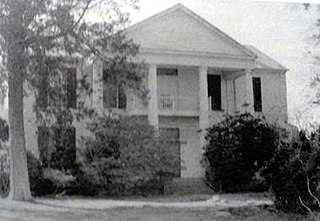
Cedar Haven was a historic Greek Revival plantation house located near Faunsdale, Alabama. It was built in 1850 by Phillip J. Weaver. Weaver was a prominent merchant and planter. He was born in Mifflintown, Pennsylvania in 1797 and relocated to Selma from Uniontown, Maryland in 1818. He ran a very successful store in Selma and also maintained a home there.
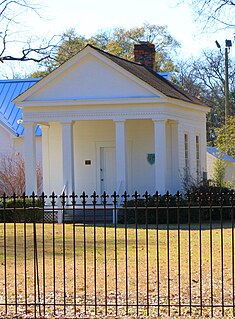
Roseland Plantation is a historic plantation complex site in Faunsdale, Alabama. The site is situated on a low hill at the end of a long driveway on the overgrown estate. It was added to the National Register of Historic Places on January 20, 1994 as a part of the Plantation Houses of the Alabama Canebrake and Their Associated Outbuildings Multiple Property Submission.
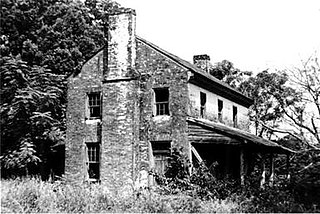
The McGehee–Stringfellow House, also known as Oak Grove, was a historic plantation house near Greensboro, Alabama, United States. It was added to the National Register of Historic Places on September 17, 1980, due to its architectural significance. It was accidentally destroyed in the 1980s during an attempt to move it to another location.

Sturdivant Hall, also known as the Watts-Parkman-Gillman Home, is a historic Greek Revival mansion and house museum in Selma, Alabama, United States. Completed in 1856, it was designed by Thomas Helm Lee for Colonel Edward T. Watts. It was added to the National Register of Historic Places on January 18, 1973, due to its architectural significance. Edward Vason Jones, known for his architectural work on the interiors at the White House during the 1960s and 70s, called it one of the finest Greek Revival antebellum mansions in the Southeast.

The Joseph T. Smitherman Historic Building, also known by a variety of other names throughout its history, is a historic Greek Revival building in Selma, Alabama. Completed in 1847, it has served many functions in the more than 160 years of its existence. The building was added to the National Register of Historic Places on June 20, 1975, due to its architectural and historical significance. It currently houses the Vaughan-Smitherman Museum, a museum depicting Selma's history.

The Stone Plantation, also known as the Young Plantation and the Barton Warren Stone House, is a historic Greek Revival-style plantation house and one surviving outbuilding along the Old Selma Road on the outskirts of Montgomery, Alabama. It was added to the Alabama Register of Landmarks and Heritage on September 28, 2000 and to the National Register of Historic Places on December 31, 2001.

The John Tyler Morgan House is a historic Greek Revival-style house in Selma, Alabama, United States. It was built by Thomas R. Wetmore in 1859 and sold to John Tyler Morgan in 1865. Morgan was an attorney and former Confederate general. Beginning in 1876, he was elected as a Democratic U.S. senator from Alabama for six terms. He used this house as his primary residence for many of those years.

The 'Wesley Plattenburg House is a historic house in Selma, Alabama. Featuring a unique combination of the Greek Revival and Italianate styles, it was completed in 1842 for Wesley Plattenburg. Plattenburg was born on April 13, 1803 in Anne Arundel County, Maryland. He had relocated to Selma and had assumed the occupation of tailor by 1829. He became a successful merchant and served on the city council of Selma for many years.

The Bryand Brand House is a historic plantation house on the east side of Alabama State Route 14 near Marion, Perry County, Alabama. The two-story Greek Revival style house was built in 1845. Unique features of the interior are the treatment of the wide central hall as a quasi-dogtrot, the double-leaf front door, and the original rabbeted sheathing found on all of the ceilings and on the walls of the central halls. The house was moved to its current site in 1978 to save it from destruction. It was added to the National Register of Historic Places on June 22, 2010.

The Driskell–Martin House is a historic house in Plantersville, Dallas County, Alabama. It is the oldest surviving high style residence in the community. The two-story wood-frame house was built for Thomas Sanford Driskell, a planter and a merchant from Virginia, in 1850. The builders were Nelson Mitchell and Massena Godwin. The house was used as a Union headquarters during the American Civil War. Their forces occupied it during Wilson's Raid through Alabama in April 1865. The house remained in the Driskell family until purchased by Dr. Thomas Munroe Martin in 1915.

Marshall's Grove is a historic plantation house near Selma, Dallas County, Alabama. The two-story wood-frame house was built in the Federal-style in 1840. It is five bays wide, with a two-tiered, pedimented portico spanning the central bay. It was built for Dr. Hugh Marshall, a native of Charleston, South Carolina who migrated to Alabama during the 1830s. Located on the northern route into Selma, it was commandeered by Union General James H. Wilson during the Battle of Selma. Marshall's wife and daughters were allowed to remain in the house during the occupation. The house was restored by Marshall's great-granddaughter, Seleta Llewellyn, during the mid-to-late 20th century. It was added to the National Register of Historic Places on February 4, 1982.
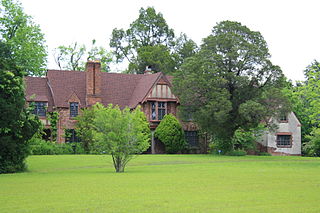
The Marcus Meyer Skinner House, also known as the Howorth House, is a historic house in Selma, Dallas County, Alabama. The large two-story Tudor Revival-style house was built in 1928 for Marcus Meyer Skinner, a renowned surgeon and native of nearby Furman. It was designed by one of Alabama's leading architects of the day, Frank Lockwood.

The Old Town Historic District is a 323-acre (131 ha) historic district in Selma, Dallas County, Alabama. It is bounded by U.S. Route 80, Broad and Franklin streets, and Dallas and Selma avenues. The boundaries were increased on December 15, 2003. The district includes examples of the Federal, Greek Revival, Italianate, Gothic Revival, Victorian, Shotgun, Queen Anne, Romanesque Revival, Renaissance Revival, and Classical Revival. It contains 629 properties, with 513 contributing and 116 noncontributing to the district. It was added to the National Register of Historic Places on May 3, 1978.
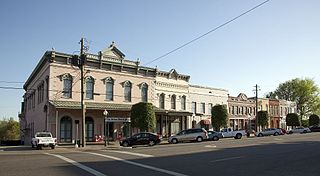
The Water Avenue Historic District is a 10-acre (4.0 ha) historic district in Selma, Dallas County, Alabama. It is centered on Water Avenue in downtown. The boundaries were increased on July 7, 2005. The district is primarily commercial, with examples of the Greek Revival, Italianate, Queen Anne, Romanesque Revival, and Renaissance Revival styles. It contains 52 properties, with 47 contributing and 5 noncontributing to the district. It was added to the National Register of Historic Places on December 26, 1972.




















